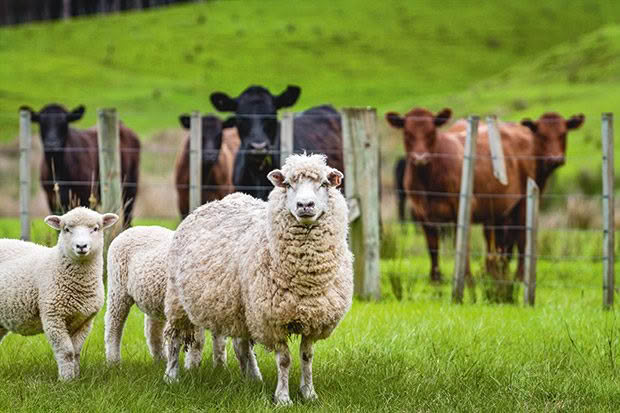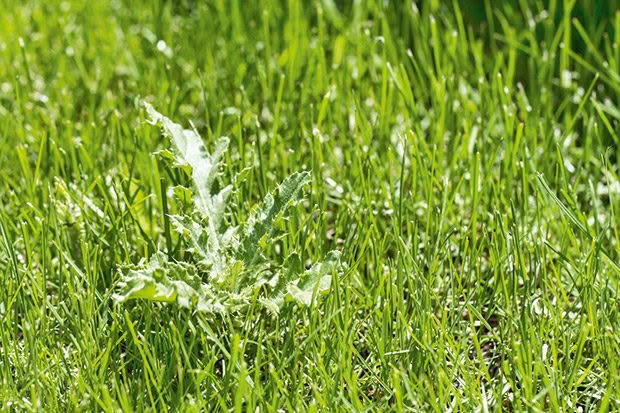16+ tips for spray-free weed control on a lifestyle block

Spraying weeds is easy, but it turns out organic methods can give you the same results if you do it right. Here are 16 practical ways to control weeds without using chemicals.
Words: Nadene Hall
It’s a common myth that organic farms have more problems with weeds. But research by weed scientist Kerry Harrington at Massey University found that isn’t the case. A comparison of two similar farms, one organic, one conventional, over eight years, found the rate of weeds in pasture was the same (approximately 5%). While you save time (not spraying) and money (not buying chemicals), organic weed management requires placing more emphasis on soil and pasture health.
1. Walk your property
If you have animals that know you well and follow you (vs those you need to herd), you may rarely walk over your pasture. However, regular checks are vital to successful organic weed control. You’re more likely to spot weeds when the area affected is small and easily managed by hand-pulling plants.
2. Don’t let weeds flower
Once plants flower, most quickly go to seed. It’s crucial to take action, such as hand-pulling or mowing before they flower, so the problem doesn’t get larger.
3. Mow
Cut weeds down when they’re young and vigorous, with dense leafy growth, to deplete their root systems. Leaves provide crucial nutrients to the root system via photosynthesis. Regular mowing stops the roots from building up a nutrient bank. Eventually, they die from lack of nutrition.

Strategic mowing will kill California thistle, no spraying required.
Research by the University of Wisconsin showed one mowing in the growing season of annual weeds and multiple mowing of perennial weeds when they’re 20-30cm high (before flowering) will kill them off.
Mowing also stops weeds from shading out ‘good’ pasture plants such as ryegrass and clover. The key is to mow higher, so you cut the leaves of weeds. You don’t want to scalp an area down to bare soil (as weed seeds will germinate), or cut back useful pasture plants too low (or they’ll stop growing too).
4. Don’t overgraze
Animals prefer tasty plants such as ryegrass and clover and will graze them down to ground level if given the opportunity. They also won’t eat most weeds. The result is the weeds get bigger, and the grass and clovers suffer (or die) due to lack of leaves. Ideally, move stock on while the pasture is still 5-8cm high, giving plants enough leaf area to feed the roots, which can then grow new stems.
5. Graze multiple species
Grazing animals eat in different ways:
• cattle (preference grass, legumes) prefer to graze the top half of a plant;
• sheep (grass, brushy plants, young weeds,) and horses (grass) like to bite plants off quite close to ground level;
• goats browse, preferably on young trees, shrubs, and brush, at or above head height – if eating pasture and weeds, they mostly nip off the tips.
The result of cross-grazing with different species is more uniform and efficient use of pasture. Weedy plants get less of an opportunity to dominate an area because they’re grazed to the same level as the grass and don’t shade it out.
Horses are notoriously picky eaters. Sheep make excellent pasture partners as they prefer to eat a lot of what horses will leave behind. You also need animals that suit your terrain. Sheep and goats tend to be better grazers on steep hills than horses and most cattle breeds.
6. Rotate stock
When you have small stock numbers, it can be tempting to place them in a paddock and leave them there to graze for long periods. However, this leads to over-grazing of palatable pasture plants and under-grazing of less palatable ones and weeds.
Over-grazing eventually kills off ‘good’ plants, leaving bare, depleted soil. Hardier weeds are then more likely to germinate. Smaller paddocks are an excellent option for cattle. They’re naturally competitive over feed, making them more likely to eat less palatable weeds such as dock.
7. Don’t help weeds to spread
One of the common ways to introduce a weed to your block is in hay, manure, compost, or when seeds or stem fragments come in on machinery.
• Check the reputation of feed and fertiliser suppliers (and transport companies who deliver it) and the cleanliness of machinery and other vehicles that come onto your property.
• If you’re using your mower or tractor to cut down weeds, make sure to clean it and the mowing deck when you move to a new area. It prevents the spread of seeds or stem fragments that could easily resprout (eg, kikuyu).
UNDERSTOCK YOUR BLOCK
It’s far better for pasture and soil health to graze slightly fewer stock than your block can carry. It’s much easier to control a little too much pasture by mowing (or converting it into hay or balage) than to continually stress pasture plants. There tend to be fewer weed outbreaks, and you can avoid buying expensive supplements.
It’s also better for stock health and growth, there’s less pressure on fencing (animals aren’t trying to push through them to get feed), and it gives you a buffer if there’s a drought or a very wet winter.
QUICK TIPS FOR CHEMICAL-FREE WEED MANAGEMENT
Research from the US found nine key strategies for maintaining good quality pasture (or crops) without the use of sprays.
• Soil test and fertilise accordingly.
• Select adapted species combinations, eg horses and sheep.
• Maintain proper soil pH.
• Use appropriate seeding rates.
• Control perennial weeds before sowing new pasture.
• Practice rotational grazing.
• Walk pastures to catch emerging weed problems.
• Control developing weed problems by hand cutting or mowing.
• Consider renovating pasture if it starts to develop a weed problem.
Source: University of Wisconsin
Love this story? Subscribe now!
 This article first appeared in NZ Lifestyle Block Magazine.
This article first appeared in NZ Lifestyle Block Magazine.
